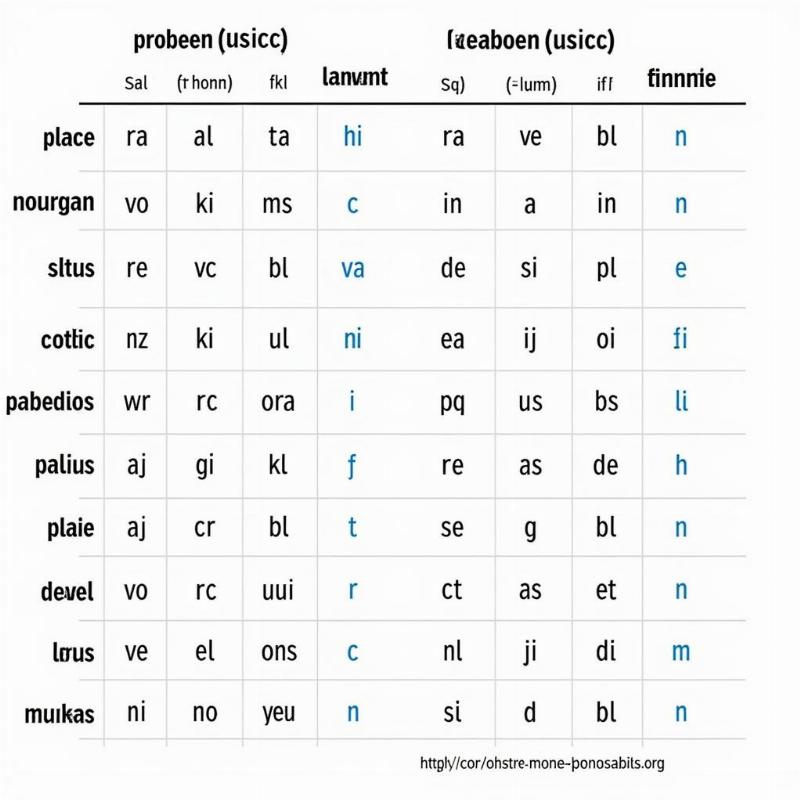The place of articulation chart is a crucial tool for anyone interested in phonetics, linguistics, or learning a new language. It visually represents the different locations in the mouth where speech sounds, or consonants, are produced. Understanding this chart can significantly enhance your pronunciation and comprehension, especially when tackling languages with sounds unfamiliar to your native tongue. This article will delve into the intricacies of the place of articulation chart, exploring its various components and offering practical tips on how to utilize it effectively.
Decoding the Place of Articulation Chart
What exactly is the place of articulation? It refers to the specific point in the vocal tract where two speech organs come closest together to modify the airflow, creating distinct consonant sounds. The place of articulation chart systematically organizes these points, ranging from the lips at the front of the mouth to the glottis deep in the throat.
Key Places of Articulation and Their Sounds
The chart typically includes the following key places of articulation:
- Bilabial: Sounds produced using both lips (e.g., /p/, /b/, /m/).
- Labiodental: Sounds created by the lower lip touching the upper teeth (e.g., /f/, /v/).
- Dental: Sounds made with the tongue tip near the upper teeth (e.g., /θ/, /ð/).
- Alveolar: Sounds produced with the tongue tip at the alveolar ridge, the bumpy area just behind the upper teeth (e.g., /t/, /d/, /n/, /s/, /z/, /l/).
- Postalveolar: Sounds produced with the tongue just behind the alveolar ridge (e.g., /ʃ/, /ʒ/, /tʃ/, /dʒ/).
- Retroflex: Sounds made by curling the tongue tip back towards the hard palate (common in some Indian languages).
- Palatal: Sounds produced with the tongue body against the hard palate (e.g., /j/).
- Velar: Sounds made with the back of the tongue against the soft palate or velum (e.g., /k/, /g/, /ŋ/).
- Uvular: Sounds produced with the back of the tongue against the uvula (found in some languages, not English).
- Pharyngeal: Sounds made by constricting the pharynx (found in some languages, not English).
- Glottal: Sounds produced at the glottis, the opening between the vocal cords (e.g., /h/).
How to Use the Place of Articulation Chart for Language Learning
The place of articulation chart can be a powerful tool for improving pronunciation, especially when learning a new language. By visualizing the placement of your tongue and lips, you can gain a better understanding of how to produce sounds accurately. For example, if you’re struggling with the retroflex sounds in Hindi, the chart can guide you in positioning your tongue correctly.
Practicing with the Chart
Start by familiarizing yourself with the different places of articulation. Then, choose a sound you want to practice and find its corresponding location on the chart. Pay close attention to the description and try to mimic the tongue and lip movements. You can use online resources to listen to native speakers pronounce the sounds and compare your own pronunciation.
Place of Articulation vs. Manner of Articulation
While the place of articulation describes where a sound is produced, the manner of articulation describes how it is produced. This involves how the airflow is restricted or modified. For a complete understanding of consonant sounds, you need to consider both the place and manner of articulation.
Combining Place and Manner for a Complete Picture
For instance, both /p/ and /b/ are bilabial sounds (same place of articulation), but /p/ is voiceless and /b/ is voiced (different manner of articulation). The chart often includes information about manner of articulation alongside place of articulation, providing a comprehensive overview of consonant production.
 Combined Place and Manner of Articulation Chart
Combined Place and Manner of Articulation Chart
Conclusion
The place of articulation chart is an invaluable resource for anyone interested in phonetics and language learning. By understanding how to use it, you can significantly improve your pronunciation and gain a deeper understanding of how speech sounds are produced. So, dive into the world of phonetics, explore the place of articulation chart, and unlock a new level of language learning!
FAQ
- What is the difference between bilabial and labiodental sounds? Bilabial sounds involve both lips, while labiodental sounds involve the lower lip and upper teeth.
- How can the place of articulation chart help me with my accent? By understanding where sounds are produced, you can adjust your tongue and lip movements to achieve more accurate pronunciation.
- Is the place of articulation chart the same for all languages? While the basic principles are similar, some languages may utilize additional places of articulation not found in English.
- Where can I find a good place of articulation chart? Many online resources and linguistics textbooks offer detailed charts, often with interactive features.
- How can I practice using the chart effectively? Combine visual study of the chart with listening to native speakers and practicing your own pronunciation.
- What is the relationship between place of articulation and manner of articulation? They work together to define consonant sounds. Place refers to where the sound is made, while manner describes how.
- Why is it important to understand the place of articulation? It improves pronunciation, aids in language learning, and provides a deeper understanding of phonetics.
About PlaTovi
PlaTovi is your trusted travel partner for exploring the wonders of India and the world. We offer a wide range of services, from customized tour packages to flight and hotel bookings, ensuring a seamless and unforgettable travel experience. Our expertise in Indian destinations makes us the ideal choice for both domestic and international travelers seeking cultural immersion and authentic experiences. For inquiries or bookings, contact us at [email protected] or call us at +91 22-2517-3581. Let PlaTovi help you plan your next adventure!